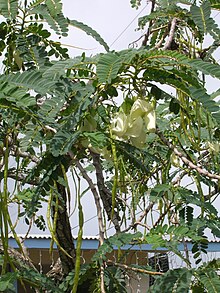bio.wikisort.org - Plant
Sesbania grandiflora,[2] commonly known as vegetable hummingbird,[3] katurai, agati, or West Indian pea, is a small leguminous tree native to Maritime Southeast Asia and Northern Australia. It has edible flowers and leaves commonly eaten in Southeast Asia and South Asia.[4]
| Sesbania grandiflora | |
|---|---|
 | |
| Scientific classification | |
| Kingdom: | Plantae |
| Clade: | Tracheophytes |
| Clade: | Angiosperms |
| Clade: | Eudicots |
| Clade: | Rosids |
| Order: | Fabales |
| Family: | Fabaceae |
| Subfamily: | Faboideae |
| Tribe: | Sesbanieae |
| Genus: | Sesbania |
| Species: | S. grandiflora |
| Binomial name | |
| Sesbania grandiflora | |
| Synonyms | |
| |
Description
Sesbania grandiflora is a fast-growing tree. The leaves are regular and rounded and the flowers white, red or pink. The fruits look like flat, long, thin green beans. The tree thrives under full exposure to sunshine and is extremely frost sensitive.
It is a small soft wooded tree up to 3–8 m (10–26 ft) tall. Leaves are 15–30 cm (6–12 in) long, with leaflets in 10–20 pairs or more and an odd one. Flowers are oblong, 1.5–10 cm (1–4 in) long in lax, with two to four flower racemes. The calyx is campanulate and shallowly two-lipped. Pods are slender, falcate or straight, and 30–45 cm (12–18 in) long, with a thick suture and approximately 30 seeds 8 mm (0.3 in) in size.





| Nutritional value per 100 g (3.5 oz) | |
|---|---|
| Energy | 113 kJ (27 kcal) |
Carbohydrates | 6.73 g |
Fat | 0.04 g |
Protein | 1.28 g |
| Vitamins | Quantity %DV† |
| Thiamine (B1) | 7% 0.083 mg |
| Riboflavin (B2) | 7% 0.081 mg |
| Niacin (B3) | 3% 0.43 mg |
| Folate (B9) | 26% 102 μg |
| Vitamin C | 88% 73 mg |
| Minerals | Quantity %DV† |
| Calcium | 2% 19 mg |
| Iron | 6% 0.84 mg |
| Magnesium | 3% 12 mg |
| Phosphorus | 4% 30 mg |
| Potassium | 4% 184 mg |
| |
| †Percentages are roughly approximated using US recommendations for adults. Source: USDA FoodData Central | |
Origin and distribution
It is native to Maritime Southeast Asia (Malaysia, Indonesia, Philippines, Brunei) to Northern Australia, and is cultivated in many parts of South India and Sri Lanka. It has many traditional uses.[5] It grows where there is good soil and a hot, humid climate.
Culinary uses
The flowers of S. grandiflora are eaten as a vegetable in Southeast Asia and South Asia, including Java and Lombok in Indonesia, the Ilocos Region of the Philippines, Vietnam, Laos, and Thailand.
In Khmer language, the flowers are called ផ្កាអង្គាដី (angkea dei) and young leaves and flowers are used in the cuisine both cooked in curries, such as Samlor mchou angkea dei and salad sauce bok amproek or toek kroeung. [citation needed]
In the Thai language, the flowers are called ดอกแค (dok khae) and are used in the cuisine both cooked in curries, such as kaeng som and kaeng khae,[6] and raw or blanched with nam phrik.[7]
In India, this plant is known as அகத்தி (Tamil), hadga (हादगा in Marathi), agasti (Odia), agasey (Kannada), అవిసె (Telugu), and both the leaves and the flowers have culinary uses. It is known as Bok phool (বকফুল) in West Bengal, India and Bangladesh, and is eaten after being fried with gram paste.
The young pods are also eaten. In Sri Lanka, agati leaves, known as Katuru murunga in Sinhala language, are sometimes added to sudhu hodhi or white curry, a widely eaten, thin coconut gravy. It is also eaten in the Maldives (locally known as Feeru Muran'ga, ފީރު މުރަނގަ).
See also
- Sesbania bispinosa
- Dolichandrone spathacea, known as Dok khae thale in Thai
- Markhamia stipulata, known as Dok khae hua mu in Thai
- Edible flowers
- List of Thai ingredients
References
- "Sesbania grandiflora (L.) Pers. — The Plant List". www.theplantlist.org. Retrieved 17 June 2019.
- Joshi S. G., Medicinal Plants, Medicinal plants, Oxford & IBH Publishing Co. Pvt. Ltd. bks)
- USDA, NRCS (n.d.). "Sesbania grandiflora". The PLANTS Database (plants.usda.gov). Greensboro, North Carolina: National Plant Data Team. Retrieved 10 November 2015.
- Cucio, Ardy L.; Aragones, Julie Ann A. Katuray Production Guide (PDF). Bureau of Plant Industry, Department of Agriculture, Republic of the Philippines.
- Kirtikar K. R. & B. D. Basu, Indian Medicinal Plants Vol-I, International Book Distributor & Publisher, Dehradun, Edition 2005, bks pp. 735–736
- LittleBigThaiKitchen (12 March 2012). "Kaeng Khae Kai (Katurai Chilli Soup with Chicken)". Archived from the original on 2021-12-19. Retrieved 17 June 2019 – via YouTube.
- Thailand Illustrated Magazine Archived 2011-07-18 at the Wayback Machine
External links
- Sesbania grandiflora on Tropicalforages.info
- Sesbania grandiflora in the AgroForestry Database of the World Agroforestry Centre
- Sesbania grandiflora on the FAO web site
- Sesbania grandiflora on the web site of the Center for New Crops & Plant Products at Purdue University.
- " Sesbania Seeds Exporter Kohenoor International Pakistan"
На других языках
[de] Turibaum
Der Turibaum (Sesbania grandiflora) ist eine Pflanzenart aus der Unterfamilie der Schmetterlingsblütler (Faboideae) innerhalb der Familie der Hülsenfrüchtler (Fabaceae). Er stammt ursprünglich aus Indien oder Südostasien und wird heute auch in Afrika und der Karibik angebaut. Der Turibaum wächst nur in feuchtem und heißem Tiefland und verträgt keine Temperaturen unter 10 °C.- [en] Sesbania grandiflora
[ru] Сесбания крупноцветковая
Сесба́ния крупноцветко́вая (лат. Sesbania grandiflora) — вид деревьев рода Сесбания (Sesbania) семейства Бобовые (Fabaceae).Другой контент может иметь иную лицензию. Перед использованием материалов сайта WikiSort.org внимательно изучите правила лицензирования конкретных элементов наполнения сайта.
WikiSort.org - проект по пересортировке и дополнению контента Википедии